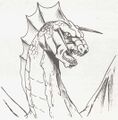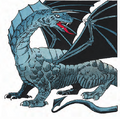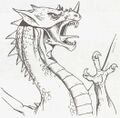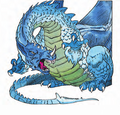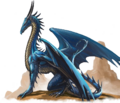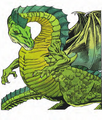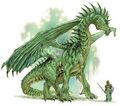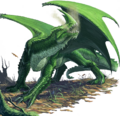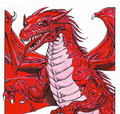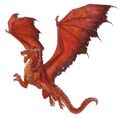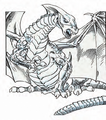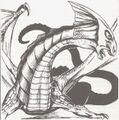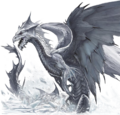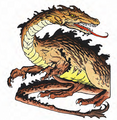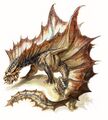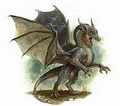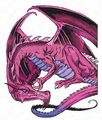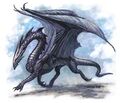Chromatic Dragon: Difference between revisions
m (77 revisions imported) |
|||
| (65 intermediate revisions by 20 users not shown) | |||
| Line 1: | Line 1: | ||
'''Chromatic Dragons''' are one of the many specific breeds of [[dragon]] native to [[Dungeons & Dragons]] and [[Pathfinder]]. They are one of the two most iconic family groupings of D&D dragons, alongside the [[Metallic Dragon]]s. Lesser D&D dragon families have include the [[Catastrophic Dragon]]s, [[Ferrous Dragon]]s, [[Gem Dragon]]s, [[Oriental Dragon]]s (or "Imperial Dragons", for [[Pathfinder]]) [[Planar Dragon]]s, and [[Epic Dragon]]s. | '''Chromatic Dragons''' are one of the many specific breeds of [[dragon]] native to [[Dungeons & Dragons]] and [[Pathfinder]]. They are one of the two most iconic family groupings of D&D dragons, alongside the [[Metallic Dragon]]s. Lesser D&D dragon families have include the [[Catastrophic Dragon]]s, [[Ferrous Dragon]]s, [[Gem Dragon]]s, [[Oriental Dragon]]s (or "Imperial Dragons", for [[Pathfinder]]) [[Planar Dragon]]s, and [[Epic Dragon]]s. | ||
In an expansion of the [[alignment]] mechanic, chromatics helped define what our frenemies on TVTropes calls "Color Coded For Your Convenience", where the general color-scheme of a dragon immediately helps you figure out what they are as a general rule. | In an expansion of the [[alignment]] mechanic, chromatics helped define what our frenemies on TVTropes calls "Color Coded For Your Convenience", where the general color-scheme of a dragon immediately helps you figure out what they are as a general rule. | ||
Chromatic Dragons are always based on "plain" colors, and are usually portrayed as Evil aligned in various different ways depending on the precise breed. Their associated patron goddess is [[Tiamat]], who materializes as a gargantuan she-dragon with five heads, corresponding to the five most iconic breeds of Chromatic Dragon. dragon magazine 65 | Chromatic Dragons are always based on "plain" colors, and are usually portrayed as Evil aligned in various different ways depending on the precise breed. Their associated patron goddess is [[Tiamat]], who materializes as a gargantuan she-dragon with five heads, corresponding to the five most iconic breeds of Chromatic Dragon. | ||
They, unlike metallics, are more likely to breed between species (of chromatics) and create mules (as shown in dragon magazine #65 and #248 which have mixtures between the breathtypes), | |||
and a light mention in 3e draconomicon as crossbreeds. | |||
Dragons can crossbreed with pretty much anything; there was a bear dragon in an Ashardalon campaign. | |||
Now, you may be wondering, “does this mean dragons can crossbreed with other dragon types?” (i.e chromatic+metallic). | |||
The answer is yes BUT the child is usually viewed as an aberration, and promptly hunted down. It is possible for a dragon to care for it, but this is extremely rare. | |||
Chromatic dragons can learn polymorph if they work for it, unlike the metallics who get it naturally, or any spell really (even dragons have their own spells they can learn). | |||
==The Original 5== | |||
===Black Dragon=== | |||
Black Dragons favor swampy lairs where they can lie in ambush crocodile-style, since they can breath underwater. They are also known as "skull dragons" for their skeletal facial features. They tend to be described as particularly cruel and sadistic, even by dragon standards. They spit gouts of acid slime as a breath weapon. | |||
<gallery> | |||
Black dragon MM 1e.jpg|1e | |||
Black dragon Monster card.jpg | |||
Black dragon MCV1.jpg | |||
Black dragon MM 2e.png|2e | |||
Black dragon 3e.jpg|3e | |||
Black dragon 4e.jpg|4e | |||
Black dragon 5e.jpg|5e | |||
5e GREATWYRM RHASHAAK.jpg | |||
Black dragon B1.png|pathfinder | |||
</gallery> | |||
===Blue Dragon=== | |||
Blue Dragons are iconic for their single enormous snout-tip horn, like a rhino's. Using powerful blasts of lightning breath to vaporize foes, they are traditionally considered denizens of the desert - which many fans find a little weird, given they are, y'know, ''bright freaking blue''. They have the ability to flat-out destroy water. Unusually this ability is exclusive to them, yet the ability to create indefinitely lasting water from nothing is ''everywhere''. 4th edition made them prefer coastal regions and other places where storms are common instead. They are traditionally portrayed as amongst the most reasonable and least malevolent of the Chromatics; show them respect, and they'll usually leave you alone. They are well known for their patience, waiting in ambush under the sand for hours or continuously hounding prey as a Persistence hunter. They are also known to form tighter family units than most other dragons, being the least likely Chromatic to eat their sibling. In 5th edition, they're back to living in deserts and dry steppes. | |||
<gallery> | |||
Blue dragon MM 1e.png|1e | |||
Blue dragon MCV1.jpg | |||
Blue dragon MM 2e.png|2e | |||
Blue dragon 3e.jpg|3e | |||
Blue dragon 4e.jpg|4e | |||
Blue dragon.jpg|5e | |||
Blue dragon B1.png|pathfinder | |||
</gallery> | |||
===Green Dragon=== | |||
Favoring forest environments, Green Dragons are characterized as manipulators and head-gamers par excellence. These dragons had it kind of rough in 3rd edition; with the change to poison rules in that edition, their traditional breath weapon, a gout of poisonous vapor, no longer worked, so they were forced to use corrosive fumes and do acid damage instead. They went back to poison after 3rd edition. They innately know Druidic spell, specifically to control plants, as they like thier forests to be dark and grim. | |||
In Pathfinder, they're actually decently likely (possibly 1 in 10, but likely lower) to be neutrally aligned. This is largely a result of them being too lost in their books to care about being evil. | |||
<gallery> | |||
Green dragon MM 1e.png|1e | |||
Green dragon MCV1.jpg | |||
Green dragon MM 2e.png|2e | |||
Green dragon 3e.jpg|3e | |||
Green dragon 4e.jpg|4e | |||
Green dragon.jpg|5e | |||
5e Fizban.green-dragons-are-poison.jpg | |||
Green dragon B1.png|pathfinder | |||
</gallery> | |||
====Mirage Dragon==== | |||
Dragons from the [[Feywild]] that are believed to be descended from green dragons. They have emerald scales and a mane of bright feathers around their necks. Their bite attack delivers a poison that may cause sleep and their breath weapon does psychic damage that causes the victim to either run away or attack an ally. They also can teleport and create illusions that deal psychic damage and make the area difficult terrain. They are less evil than green dragons and are closely allied with the [[Eladrin]]. | |||
===Red Dragon=== | |||
The most iconic and traditional of all D&D dragons, Red Dragons are arrogant, greedy, hot-tempered, flame-spewing, power-hungry, malevolent brutes who enjoy eating maidens. They live and swim in volcano lairs, but also the highest vantage point if else. Of the Chromatics, Reds have the highest infant mortality rate; not only do the parents not give the least amount of shits but also, everyone doesn't want to deal with more red dragons. Such egos red dragons have that if they hear another red dragon dieing, it sets off a chain of rampages where all the villages in a region get razed just so they all don't get upstaged. A red dragon flesh is also so spicy that it makes Carolina Reaper peppers taste mild. | |||
<gallery> | |||
Red dragon MM 1e.png|1e | |||
Red dragon Monster card.jpg | |||
Red dragon MCV1.jpg | |||
Red dragon MM 2e.png|2e | |||
Red dragon 3e.jpg|3e | |||
Red dragon 4e.jpg|4e | |||
Red Dragon.jpg|5e | |||
Red dragon B1.png|pathfinder | |||
</gallery> | |||
====Battle Dragon==== | |||
Battle Dragons are a hybrid of multiple kinds of dragons bred by [[Gruumsh]]. They resemble a mix of a red and gold dragon with green scaled tipped with bronze, red, or gold, with brilliant red wings, and with sharp horns growing on their limbs, tail, and back of the head. Their breath weapon does radiant damage, their bite weakens enemies, and they can give allies temporary hitpoints with their battlecry. | |||
====Pact Dragon==== | |||
Red dragons that have changed as a result of being bred by the [[Githyanki]] in the [[Astral Sea]] for use as mounts. They are smaller than red dragons and have darker scales and silvery eyes. They have the ability to teleport with their rider and can direct damage done to themselves to their rider or vice versa. | |||
===White Dragon=== | |||
Smallest and weakest of their kind, White Dragons are feral and savage, notably inferior in intelligence to the other Chromatic breeds (that doesn't mean they are stupid though, they just don't like to use their brains that much). Their icy breath weapon is nothing to sneeze at, though. They even use it to encase their hoard and trophies in ice so that they can decorate their lair. It also makes it pretty difficult for potential thieves to come and grab something, as they first have to break the ice to get to the stuff, at risk of having the dragon return and add the said thieves to its frozen collection. Crystal dragons are known to take their eggs and raise them to make them less evil; this may result in a white dragon that uses its brain more and defies the stereotype. | |||
<gallery> | |||
White dragon MM 1e.png|1e | |||
White Dragon MM 2e.png|2e | |||
Dragon MCV1.jpg | |||
White dragon MCV1.jpg | |||
White dragon 3e.jpg|3e | |||
White dragon 4e.jpg|4e | |||
White dragon.jpg|5e | |||
White dragon B1.png|pathfinder | |||
</gallery> | |||
====Frostforged Wyrm==== | |||
A Frostforged Wyrm is a white dragon that was enslaved by demons and encased in cold-forged iron plates held in place by nails driven into their flesh. They are driven insane by the pain and are used as short-lived weapons. | |||
==Other Chromatic Dragons== | |||
===Brown Dragon=== | |||
There are two distinct varieties of Brown Dragon in D&D lore; the [[Forgotten Realms]] version and the [[Nentir Vale]] version. | |||
The Realms version debuted in [[Advanced Dungeons & Dragons]] 2nd edition, in "The Old Empires", before being updated in the Monstrous Compendium Appendix: Forgotten Realms [[splatbook]], and from there making it on to the Monstrous Manual. This dragon, also known as the "Great Desert Dragon", is a flightless burrowing dragon that inhabits the desert regions of the Realms, namely Raurin and Eastern Mulhorand, where it competes with the better-known Blue Dragon for prey. Armed with an acidic spray, these Brown Dragons prefer to dig themselves into the sands and then launch themselves at any edible creature that gets nearby. Their favorite food is horseflesh. It's noted that the natives of the deserts have a peculiar respect for these dragons, so they often describe them as less evil than their Blue Dragon rivals. It may be because Brown Dragons have little interest outside of being apex predators and are freely hunted by the natives, whilst Blue Dragons are more inclined to setting themselves up as overlords reigning over human slaves. | |||
The [[World Axis]] version is, of course, unique to [[Dungeons & Dragons 4th Edition]], appearing in the Chromatic [[Draconomicon]]. This version possesses distinctive sail-like frills down its sides and ''is'' capable of flight, although they are much better at burrowing. Also known as "Sand Dragons", these Brown Dragons are largely disinterested in the idea of ruling over anything; their most predominant trait is that they are gourmet epicures. Their love of food and cooking skills is so great that a Brown Dragon's hoard is often based on a mixture of exotic animals, long-forgotten (and thus highly valuable!) cook books, cooking utensils made out of fabulously expensive materials, rare spices, precious wines and liquors... basically, Sand Dragons are the only dragons who would earn an entry in the Great Book of Grudges for carrying off barrels of Bugman's XXXXXXXX and enslaving dwarven brewers. Best characterized as hedonists, 4e Brown Dragons only care about living a life of ease and comfort, and so they actively prefer to avoid stirring up trouble with humanoids - raiding a farmer's flocks every now and then is much less hassle than demanding human sacrifices from a neighboring village. These Brown Dragons have a breath weapon made of high-velocity sand gouts, which can scour flesh from bone. | |||
<gallery> | |||
Brown dragon MM 2e.png| 2e | |||
Brown dragon MoF.png|3e | |||
Brown dragon.jpg|4e | |||
</gallery> | |||
====Blight Dragon==== | |||
The Blight Dragon is a brown dragon from the [[Shadowfell]] that also appeared in the Chromatic Draconomicon. Blight Dragons have rust-colored scales. They have the ability to drain life and create dust storms, and their breath weapon is a searing wind of grit and dust that rots whatever it touches, doing both fire and necrotic damage. Very little is known about them besides them having a compulsion to drain life out of everything in their environment, turning the place they live into a lifeless wasteland. They do collect treasure, but the book doesn't say what kind. | |||
===Gray Dragon (Dragonlance)=== | |||
The Gray Dragon, spelled with an "a", first appeared in Dragon Magazine #146. They are native to the Dragonlance setting. They are similar in size to white dragons and are just as evil, but are much smarter and more heavily armored. Their breath weapon is a cone of paralyzing cold air. | |||
===Gray Dragon (Nentir Vale)=== | |||
Uniquely amongst the chromatic dragons, this version of the gray dragons is only found in the [[Nentir Vale]] setting, having been invented for [[Dungeons & Dragons 4th Edition]] and appearing in the Chromatic [[Draconomicon]]. They are, however, based on an older dragon; the [[Fang Dragon]]. They don't even try to hide this fact; their literal in-game lore is that [[Tiamat]] created Fang Dragons, found them to be disappointments, and so tried to improve the breed. She took a clutch of Fang Dragon eggs, infused them with [[medusa]] blood, then had a [[basilisk]] brood them in a nest made of [[cockatrice]] feathers for a year. When they hatched, they had gained the ability to both petrify creatures with their touch and to spew a caustic slime that quickly dried into a stone-hard substance. Impressed with the results, she set them to hunting down their former relatives, and thus there are few if any Fang Dragons left to be found in the Nentir Vale world. | |||
Personality-wise, gray dragons - also known as Stone or Spike Dragons, and sometimes referred to as Fang Dragons by those who confuse them with their ancestors - can be best summarized as "White Dragon 2.0". They're not ''stupid'', but they are rapacious, venal, brutish, fickle, voracious predators absolutely ''obsessed'' with hunting. A gray dragon not only thinks it's the biggest, meanest predator around, it wants to ''prove it'', so their diet is largely made up of humanoids and monsters, because these pose an actual challenge to bring down and eat. | |||
Gray Dragons inhabit rocky badlands and border-regions, where they typically have both a central "lair", where they keep their hoards, and multiple "outposts", which they migrate between as they scour their territory for prey. | |||
<gallery> | |||
Fang dragon MoF.jpg | |||
Grey dragon.jpg | |||
</gallery> | |||
===Grey Dragon=== | |||
Prior to the Gray Dragon, the ''Grey'' Dragon appeared in 1st Edition in [[Dragon Magazine]] #62 as a unique character alongside its brother the [[Ferrous Dragon|Steel Dragon]]. Also know by the name Rahab, this Chaotic Evil dragon lairs in a deep cavern in a secluded mountain range, keeping scores of humans, dwarves, and goblins as slaves. His breath weapon is a ''charm'' spell that affects characters for the rest of their lives unless dispelled by ''remove curse''. Rahab is also perpetually surrounded by magical darkness that extends three feet from his body. | |||
<gallery> | |||
grey dragon Dragon 62.png | |||
</gallery> | |||
===Orange Dragon=== | |||
Orange Dragons have only appeared in one format, unlike almost every other dragon on this list, which is a rather sad form of uniqueness. They debuted in [[Dragon Magazine]] #65 alongside the Yellow and Purple Dragons in the article "The Missing Dragons" for [[Advanced Dungeons & Dragons]] 1st edition. In this source, they were described as a "secondary chromatic", the result of crossbreeding between two other breeds of chromatic dragon - in this case, the Red and Yellow Dragons. Like most 1e monsters, there wasn't a lot of lore to them; basically, all we're told is that they love to hunt in and near water, inhabiting cave systems adjacent to swamps, rivers, and lakes, they tend to hunt at night to compensate for their glaring color scheme, and their breath weapon is a gout of liquid sodium... basically, clinging fire that ''explodes'' if it touches water. | |||
The Orange Dragon was subsequently updated to AD&D 2nd edition in [[Dragon Magazine]] #248: "The Return of the Missing Dragons". Now also known as "Sodium Dragons", they are stated to only inhabit the riverbanks and lake shores of steamy tropical rainforests, where the abundant moisture keeps their sodium breath weapon from going too out of control. They are excellent swimmers, but unlike other water-loving dragons have no inherent water-breathing abilities. Black dragons keep out of their way, as orange dragons are bigger, stronger, and much nastier, but there is a bitter rivalry between orange and [[Metallic Dragon|bronze dragons]]. It also appears in the dragon compendium. | |||
<gallery> | |||
orange dragon Dragon 65.jpg | |||
orange dragon Dragon 248 1.png | |||
orange dragon Dragon 248 2.jpg | |||
</gallery> | |||
===Pink Dragon=== | |||
Pink Dragons were mostly a "joke monster". They appeared in [[Dragon Magazine]] #156. Their breath weapon was a cloud of pink bubbles that blinds people hit by it and makes the ground slippery. They also do not have the frightful presence that dragons have. Pink Dragons are chaotic neutral and enjoy telling jokes, but will eat you if you don't laugh. | |||
===Purple Dragon=== | |||
There are two distinct kinds of Purple Dragon - three, if one considers the [[Deep Dragon]] to be the [[Forgotten Realms]] version of the Purple Dragon. Which is a reasonable assumption to make, considering... but we'll get to that. | |||
The Purple Dragon first debuted in [[Dragon Magazine]] #65 alongside the Yellow and Orange Dragons in the article "The Missing Dragons" for [[Advanced Dungeons & Dragons]] 1st edition. In this source, the Purple Dragon was described as a "secondary chromatic", a subspecies of dragon created by the crossbreeding of Red and Blue Dragons. As these were the two most powerful Chromatic Dragons, the Purple Dragon was the most powerful of the secondary chromatics. Very little lore is actually presented about this prototype Purple Dragon, save that they breath an explosive plasma blast (a hybrid of the fire and lightning breaths of their ancestors), and they tend to favor deep cavern lairs, including in what would become the [[Underdark]]. | |||
This purple dragon was subsequently updated to AD&D 2nd edition in [[Dragon Magazine]] #248: "The Return of the Missing Dragons". Now also known as "Energy Dragons", they were still suspected to be the product of Red and Blue Dragon crossbreeding, but they also gained a new potential origin as the children of a lost member of the [[Dragon Gods]], a sister to [[Tiamat]] whom she destroyed. This version of the purple dragon has a lot more fluff than its 1e predecessor. Energy dragons are characterized as the most sinister, evil and sadistic of all the Chromatics. Favoring deep cavern and [[Underdark]] lairs, they prefer to emerge from the depths to hunt prairies, plains, and low foothills, preferably at night and/or in the middle of a fierce thunderstorm - not because they have any sensitivity to light, but because these dark conditions amplify the terror of their raids. They favor meat, but will begrudgingly supplement their diet with tuberous vegetables such as potatoes, onions and carrots if they must, but this makes them even meaner. They still spit plasma, but now they can do so in three forms; a diffuse cloud, a more focused conical blast, or a tightly focused scything "blade" of energy. It also appears in the dragon compendium. | |||
In the [[Nentir Vale]], a different kind of purple dragon can be found, invented for [[Dungeons & Dragons 4th Edition]] and appearing in the Chromatic [[Draconomicon]]. This version, however, is largely based on the [[Deep Dragon]] of the [[Forgotten Realms]], being an [[Underdark]]-dwelling serpentine species rarely seen on the surface. However, it also has its own unique quirks; the [[World Axis]] purple dragon is an inveterate explorer and loves nothing more than to spelunk into new territories - wandering around the Underdark and exploring new places is a genuine delight for them, and they are notably less sadistic and manipulative than their counterparts from other planes and editions. They possess a breath weapon unique to them; clouds of psychotropic venom that cause Psychic damage, and also have the unique ability to turn into insubstantial shadows. | |||
<gallery> | |||
purple dragon Dragon 65.jpg | |||
purple dragon Dragon 248 1.jpg | |||
purple dragon Dragon 248 2.jpg | |||
purple dragon Dragon 248 3.jpg | |||
Deep dragon MCFR.png | |||
Deep dragon MM 2e.png | |||
Deep dragon MoF.jpg | |||
</gallery> | |||
== | ====Deathmask Dragon==== | ||
A Deathmask dragon is a purple dragon from the abyss that grows strong by assimilating the body and soul of its slain victims. They have long, slender bodies with many legs like a centipede, wings that somehow let them fly despite looking too small, and they are covered in the moaning faces of everyone they have killed. They can use psychic attacks and their bite and breath both do necrotic damage, and the breath can also cause blindness. | |||
== | ====Wretch Dragon==== | ||
[[ | A variant of the Nentir Vale purple dragon that been raised by the [[Fomorian]]s. They are fatter and much uglier than purple dragons. Their breath weapon does psychic damage and teleports victims that fail their save. They can release bursts of filth from the growths on their bodies that inflict psychic and necrotic damage. | ||
== | ===Yellow Dragon=== | ||
[[ | Similarly to the [[Metallic Dragon|Steel Dragon]], the Yellow Dragon is a Chromatic with a somewhat convoluted history, with different appearances in different settings and different editions. | ||
The original Yellow Dragon appeared in [[Advanced Dungeons & Dragons]] 1st edition in the article "The Missing Dragons", for [[Dragon Magazine]] #65. Here, they shared the limelight with the Purple and Orange Dragons. Unlike them, though, the yellow dragon was characterized as a "missing Primary Chromatic", the ancestor of the Green and newly introduced Orange Dragons. Very little lore is provided for this Yellow Dragon, save that they can spit sprays of salt crystals and they favour lairs along oceanic coasts and amongst salt flats. | |||
[[ | |||
This version of the Yellow Dragon would be updated to 2e in the article "The Return of the Missing Dragons" in [[Dragon Magazine]] #248. Like its purple and orange counterparts, this version underwent a major lore expansion. Now known as "Salt Dragons", and with a graphic redesign from a fairly generic dragon in #65 to a more "giant snake with dragon legs" look, this 2e Yellow Dragon was characterized as a vicious, sadistic ambush hunter that dwelled in seashores, salt marshes, salt flats and inland seas. They often cooperate with [[sahuagin]] or any other race that is willing to live in the same area. They still spray blinding gouts of salt and can produce green and orange dragon offspring through crossbreeding. A new bit of lore here is that yellow dragons may be connected to a slain sister-goddess of [[Tiamat]]. It also appears in the dragon compendium. | |||
[[ | |||
Whilst this was going on, another form of Yellow Dragon was taking shape over in the [[Forgotten Realms]]. Debuting in the original [[Draconomicon]], the Faerunian yellow dragon is a desert-dwelling breed that clashes with the blue and brown dragons. Able to expel high-velocity, scorching hot wind laced with flesh-scouring sand, they are burrowing ambush predators, specifically favoring the antlion tactic of "dig a deep pit, lurk at the bottom, eat anything that falls in. They are hyper-territorial isolationists, refusing to tolerate each other except during the mating season. These dragons actually made it into the Monstrous Manual, alongside the brown dragon and the [[Deep Dragon]], which is something that can't be said for the Dragon Magazine chromatics. | |||
[[ | |||
Yellow dragons haven't been seen since the days of AD&D. Not even Monsters of Faerun, which revived the Brown Dragon, [[Deep Dragon]], [[Fang Dragon]], [[Shadow Dragon]], and Weredragon (under the name [[Song Dragon]]), brought them back. | |||
<gallery> | |||
yellow dragon Dragon 65.jpg | |||
yellow dragon Dragon 248 1.jpg | |||
yellow dragon Dragon 248 2.jpg | |||
Yellow dragon MM 2e.png | |||
</gallery> | |||
{{D&D-Dragons}} | {{D&D-Dragons}} | ||
[[Category:Pathfinder]] | [[Category:Pathfinder]] | ||
Latest revision as of 10:09, 20 June 2023
Chromatic Dragons are one of the many specific breeds of dragon native to Dungeons & Dragons and Pathfinder. They are one of the two most iconic family groupings of D&D dragons, alongside the Metallic Dragons. Lesser D&D dragon families have include the Catastrophic Dragons, Ferrous Dragons, Gem Dragons, Oriental Dragons (or "Imperial Dragons", for Pathfinder) Planar Dragons, and Epic Dragons.
In an expansion of the alignment mechanic, chromatics helped define what our frenemies on TVTropes calls "Color Coded For Your Convenience", where the general color-scheme of a dragon immediately helps you figure out what they are as a general rule.
Chromatic Dragons are always based on "plain" colors, and are usually portrayed as Evil aligned in various different ways depending on the precise breed. Their associated patron goddess is Tiamat, who materializes as a gargantuan she-dragon with five heads, corresponding to the five most iconic breeds of Chromatic Dragon.
They, unlike metallics, are more likely to breed between species (of chromatics) and create mules (as shown in dragon magazine #65 and #248 which have mixtures between the breathtypes), and a light mention in 3e draconomicon as crossbreeds. Dragons can crossbreed with pretty much anything; there was a bear dragon in an Ashardalon campaign. Now, you may be wondering, “does this mean dragons can crossbreed with other dragon types?” (i.e chromatic+metallic). The answer is yes BUT the child is usually viewed as an aberration, and promptly hunted down. It is possible for a dragon to care for it, but this is extremely rare.
Chromatic dragons can learn polymorph if they work for it, unlike the metallics who get it naturally, or any spell really (even dragons have their own spells they can learn).
The Original 5[edit]
Black Dragon[edit]
Black Dragons favor swampy lairs where they can lie in ambush crocodile-style, since they can breath underwater. They are also known as "skull dragons" for their skeletal facial features. They tend to be described as particularly cruel and sadistic, even by dragon standards. They spit gouts of acid slime as a breath weapon.
-
1e
-
-
-
2e
-
3e
-
4e
-
5e
-
-
pathfinder
Blue Dragon[edit]
Blue Dragons are iconic for their single enormous snout-tip horn, like a rhino's. Using powerful blasts of lightning breath to vaporize foes, they are traditionally considered denizens of the desert - which many fans find a little weird, given they are, y'know, bright freaking blue. They have the ability to flat-out destroy water. Unusually this ability is exclusive to them, yet the ability to create indefinitely lasting water from nothing is everywhere. 4th edition made them prefer coastal regions and other places where storms are common instead. They are traditionally portrayed as amongst the most reasonable and least malevolent of the Chromatics; show them respect, and they'll usually leave you alone. They are well known for their patience, waiting in ambush under the sand for hours or continuously hounding prey as a Persistence hunter. They are also known to form tighter family units than most other dragons, being the least likely Chromatic to eat their sibling. In 5th edition, they're back to living in deserts and dry steppes.
-
1e
-
-
2e
-
3e
-
4e
-
5e
-
pathfinder
Green Dragon[edit]
Favoring forest environments, Green Dragons are characterized as manipulators and head-gamers par excellence. These dragons had it kind of rough in 3rd edition; with the change to poison rules in that edition, their traditional breath weapon, a gout of poisonous vapor, no longer worked, so they were forced to use corrosive fumes and do acid damage instead. They went back to poison after 3rd edition. They innately know Druidic spell, specifically to control plants, as they like thier forests to be dark and grim.
In Pathfinder, they're actually decently likely (possibly 1 in 10, but likely lower) to be neutrally aligned. This is largely a result of them being too lost in their books to care about being evil.
-
1e
-
-
2e
-
3e
-
4e
-
5e
-
-
pathfinder
Mirage Dragon[edit]
Dragons from the Feywild that are believed to be descended from green dragons. They have emerald scales and a mane of bright feathers around their necks. Their bite attack delivers a poison that may cause sleep and their breath weapon does psychic damage that causes the victim to either run away or attack an ally. They also can teleport and create illusions that deal psychic damage and make the area difficult terrain. They are less evil than green dragons and are closely allied with the Eladrin.
Red Dragon[edit]
The most iconic and traditional of all D&D dragons, Red Dragons are arrogant, greedy, hot-tempered, flame-spewing, power-hungry, malevolent brutes who enjoy eating maidens. They live and swim in volcano lairs, but also the highest vantage point if else. Of the Chromatics, Reds have the highest infant mortality rate; not only do the parents not give the least amount of shits but also, everyone doesn't want to deal with more red dragons. Such egos red dragons have that if they hear another red dragon dieing, it sets off a chain of rampages where all the villages in a region get razed just so they all don't get upstaged. A red dragon flesh is also so spicy that it makes Carolina Reaper peppers taste mild.
-
1e
-
-
-
2e
-
3e
-
4e
-
5e
-
pathfinder
Battle Dragon[edit]
Battle Dragons are a hybrid of multiple kinds of dragons bred by Gruumsh. They resemble a mix of a red and gold dragon with green scaled tipped with bronze, red, or gold, with brilliant red wings, and with sharp horns growing on their limbs, tail, and back of the head. Their breath weapon does radiant damage, their bite weakens enemies, and they can give allies temporary hitpoints with their battlecry.
Pact Dragon[edit]
Red dragons that have changed as a result of being bred by the Githyanki in the Astral Sea for use as mounts. They are smaller than red dragons and have darker scales and silvery eyes. They have the ability to teleport with their rider and can direct damage done to themselves to their rider or vice versa.
White Dragon[edit]
Smallest and weakest of their kind, White Dragons are feral and savage, notably inferior in intelligence to the other Chromatic breeds (that doesn't mean they are stupid though, they just don't like to use their brains that much). Their icy breath weapon is nothing to sneeze at, though. They even use it to encase their hoard and trophies in ice so that they can decorate their lair. It also makes it pretty difficult for potential thieves to come and grab something, as they first have to break the ice to get to the stuff, at risk of having the dragon return and add the said thieves to its frozen collection. Crystal dragons are known to take their eggs and raise them to make them less evil; this may result in a white dragon that uses its brain more and defies the stereotype.
-
1e
-
2e
-
-
-
3e
-
4e
-
5e
-
pathfinder
Frostforged Wyrm[edit]
A Frostforged Wyrm is a white dragon that was enslaved by demons and encased in cold-forged iron plates held in place by nails driven into their flesh. They are driven insane by the pain and are used as short-lived weapons.
Other Chromatic Dragons[edit]
Brown Dragon[edit]
There are two distinct varieties of Brown Dragon in D&D lore; the Forgotten Realms version and the Nentir Vale version.
The Realms version debuted in Advanced Dungeons & Dragons 2nd edition, in "The Old Empires", before being updated in the Monstrous Compendium Appendix: Forgotten Realms splatbook, and from there making it on to the Monstrous Manual. This dragon, also known as the "Great Desert Dragon", is a flightless burrowing dragon that inhabits the desert regions of the Realms, namely Raurin and Eastern Mulhorand, where it competes with the better-known Blue Dragon for prey. Armed with an acidic spray, these Brown Dragons prefer to dig themselves into the sands and then launch themselves at any edible creature that gets nearby. Their favorite food is horseflesh. It's noted that the natives of the deserts have a peculiar respect for these dragons, so they often describe them as less evil than their Blue Dragon rivals. It may be because Brown Dragons have little interest outside of being apex predators and are freely hunted by the natives, whilst Blue Dragons are more inclined to setting themselves up as overlords reigning over human slaves.
The World Axis version is, of course, unique to Dungeons & Dragons 4th Edition, appearing in the Chromatic Draconomicon. This version possesses distinctive sail-like frills down its sides and is capable of flight, although they are much better at burrowing. Also known as "Sand Dragons", these Brown Dragons are largely disinterested in the idea of ruling over anything; their most predominant trait is that they are gourmet epicures. Their love of food and cooking skills is so great that a Brown Dragon's hoard is often based on a mixture of exotic animals, long-forgotten (and thus highly valuable!) cook books, cooking utensils made out of fabulously expensive materials, rare spices, precious wines and liquors... basically, Sand Dragons are the only dragons who would earn an entry in the Great Book of Grudges for carrying off barrels of Bugman's XXXXXXXX and enslaving dwarven brewers. Best characterized as hedonists, 4e Brown Dragons only care about living a life of ease and comfort, and so they actively prefer to avoid stirring up trouble with humanoids - raiding a farmer's flocks every now and then is much less hassle than demanding human sacrifices from a neighboring village. These Brown Dragons have a breath weapon made of high-velocity sand gouts, which can scour flesh from bone.
-
2e
-
3e
-
4e
Blight Dragon[edit]
The Blight Dragon is a brown dragon from the Shadowfell that also appeared in the Chromatic Draconomicon. Blight Dragons have rust-colored scales. They have the ability to drain life and create dust storms, and their breath weapon is a searing wind of grit and dust that rots whatever it touches, doing both fire and necrotic damage. Very little is known about them besides them having a compulsion to drain life out of everything in their environment, turning the place they live into a lifeless wasteland. They do collect treasure, but the book doesn't say what kind.
Gray Dragon (Dragonlance)[edit]
The Gray Dragon, spelled with an "a", first appeared in Dragon Magazine #146. They are native to the Dragonlance setting. They are similar in size to white dragons and are just as evil, but are much smarter and more heavily armored. Their breath weapon is a cone of paralyzing cold air.
Gray Dragon (Nentir Vale)[edit]
Uniquely amongst the chromatic dragons, this version of the gray dragons is only found in the Nentir Vale setting, having been invented for Dungeons & Dragons 4th Edition and appearing in the Chromatic Draconomicon. They are, however, based on an older dragon; the Fang Dragon. They don't even try to hide this fact; their literal in-game lore is that Tiamat created Fang Dragons, found them to be disappointments, and so tried to improve the breed. She took a clutch of Fang Dragon eggs, infused them with medusa blood, then had a basilisk brood them in a nest made of cockatrice feathers for a year. When they hatched, they had gained the ability to both petrify creatures with their touch and to spew a caustic slime that quickly dried into a stone-hard substance. Impressed with the results, she set them to hunting down their former relatives, and thus there are few if any Fang Dragons left to be found in the Nentir Vale world.
Personality-wise, gray dragons - also known as Stone or Spike Dragons, and sometimes referred to as Fang Dragons by those who confuse them with their ancestors - can be best summarized as "White Dragon 2.0". They're not stupid, but they are rapacious, venal, brutish, fickle, voracious predators absolutely obsessed with hunting. A gray dragon not only thinks it's the biggest, meanest predator around, it wants to prove it, so their diet is largely made up of humanoids and monsters, because these pose an actual challenge to bring down and eat.
Gray Dragons inhabit rocky badlands and border-regions, where they typically have both a central "lair", where they keep their hoards, and multiple "outposts", which they migrate between as they scour their territory for prey.
Grey Dragon[edit]
Prior to the Gray Dragon, the Grey Dragon appeared in 1st Edition in Dragon Magazine #62 as a unique character alongside its brother the Steel Dragon. Also know by the name Rahab, this Chaotic Evil dragon lairs in a deep cavern in a secluded mountain range, keeping scores of humans, dwarves, and goblins as slaves. His breath weapon is a charm spell that affects characters for the rest of their lives unless dispelled by remove curse. Rahab is also perpetually surrounded by magical darkness that extends three feet from his body.
Orange Dragon[edit]
Orange Dragons have only appeared in one format, unlike almost every other dragon on this list, which is a rather sad form of uniqueness. They debuted in Dragon Magazine #65 alongside the Yellow and Purple Dragons in the article "The Missing Dragons" for Advanced Dungeons & Dragons 1st edition. In this source, they were described as a "secondary chromatic", the result of crossbreeding between two other breeds of chromatic dragon - in this case, the Red and Yellow Dragons. Like most 1e monsters, there wasn't a lot of lore to them; basically, all we're told is that they love to hunt in and near water, inhabiting cave systems adjacent to swamps, rivers, and lakes, they tend to hunt at night to compensate for their glaring color scheme, and their breath weapon is a gout of liquid sodium... basically, clinging fire that explodes if it touches water.
The Orange Dragon was subsequently updated to AD&D 2nd edition in Dragon Magazine #248: "The Return of the Missing Dragons". Now also known as "Sodium Dragons", they are stated to only inhabit the riverbanks and lake shores of steamy tropical rainforests, where the abundant moisture keeps their sodium breath weapon from going too out of control. They are excellent swimmers, but unlike other water-loving dragons have no inherent water-breathing abilities. Black dragons keep out of their way, as orange dragons are bigger, stronger, and much nastier, but there is a bitter rivalry between orange and bronze dragons. It also appears in the dragon compendium.
Pink Dragon[edit]
Pink Dragons were mostly a "joke monster". They appeared in Dragon Magazine #156. Their breath weapon was a cloud of pink bubbles that blinds people hit by it and makes the ground slippery. They also do not have the frightful presence that dragons have. Pink Dragons are chaotic neutral and enjoy telling jokes, but will eat you if you don't laugh.
Purple Dragon[edit]
There are two distinct kinds of Purple Dragon - three, if one considers the Deep Dragon to be the Forgotten Realms version of the Purple Dragon. Which is a reasonable assumption to make, considering... but we'll get to that.
The Purple Dragon first debuted in Dragon Magazine #65 alongside the Yellow and Orange Dragons in the article "The Missing Dragons" for Advanced Dungeons & Dragons 1st edition. In this source, the Purple Dragon was described as a "secondary chromatic", a subspecies of dragon created by the crossbreeding of Red and Blue Dragons. As these were the two most powerful Chromatic Dragons, the Purple Dragon was the most powerful of the secondary chromatics. Very little lore is actually presented about this prototype Purple Dragon, save that they breath an explosive plasma blast (a hybrid of the fire and lightning breaths of their ancestors), and they tend to favor deep cavern lairs, including in what would become the Underdark.
This purple dragon was subsequently updated to AD&D 2nd edition in Dragon Magazine #248: "The Return of the Missing Dragons". Now also known as "Energy Dragons", they were still suspected to be the product of Red and Blue Dragon crossbreeding, but they also gained a new potential origin as the children of a lost member of the Dragon Gods, a sister to Tiamat whom she destroyed. This version of the purple dragon has a lot more fluff than its 1e predecessor. Energy dragons are characterized as the most sinister, evil and sadistic of all the Chromatics. Favoring deep cavern and Underdark lairs, they prefer to emerge from the depths to hunt prairies, plains, and low foothills, preferably at night and/or in the middle of a fierce thunderstorm - not because they have any sensitivity to light, but because these dark conditions amplify the terror of their raids. They favor meat, but will begrudgingly supplement their diet with tuberous vegetables such as potatoes, onions and carrots if they must, but this makes them even meaner. They still spit plasma, but now they can do so in three forms; a diffuse cloud, a more focused conical blast, or a tightly focused scything "blade" of energy. It also appears in the dragon compendium.
In the Nentir Vale, a different kind of purple dragon can be found, invented for Dungeons & Dragons 4th Edition and appearing in the Chromatic Draconomicon. This version, however, is largely based on the Deep Dragon of the Forgotten Realms, being an Underdark-dwelling serpentine species rarely seen on the surface. However, it also has its own unique quirks; the World Axis purple dragon is an inveterate explorer and loves nothing more than to spelunk into new territories - wandering around the Underdark and exploring new places is a genuine delight for them, and they are notably less sadistic and manipulative than their counterparts from other planes and editions. They possess a breath weapon unique to them; clouds of psychotropic venom that cause Psychic damage, and also have the unique ability to turn into insubstantial shadows.
Deathmask Dragon[edit]
A Deathmask dragon is a purple dragon from the abyss that grows strong by assimilating the body and soul of its slain victims. They have long, slender bodies with many legs like a centipede, wings that somehow let them fly despite looking too small, and they are covered in the moaning faces of everyone they have killed. They can use psychic attacks and their bite and breath both do necrotic damage, and the breath can also cause blindness.
Wretch Dragon[edit]
A variant of the Nentir Vale purple dragon that been raised by the Fomorians. They are fatter and much uglier than purple dragons. Their breath weapon does psychic damage and teleports victims that fail their save. They can release bursts of filth from the growths on their bodies that inflict psychic and necrotic damage.
Yellow Dragon[edit]
Similarly to the Steel Dragon, the Yellow Dragon is a Chromatic with a somewhat convoluted history, with different appearances in different settings and different editions.
The original Yellow Dragon appeared in Advanced Dungeons & Dragons 1st edition in the article "The Missing Dragons", for Dragon Magazine #65. Here, they shared the limelight with the Purple and Orange Dragons. Unlike them, though, the yellow dragon was characterized as a "missing Primary Chromatic", the ancestor of the Green and newly introduced Orange Dragons. Very little lore is provided for this Yellow Dragon, save that they can spit sprays of salt crystals and they favour lairs along oceanic coasts and amongst salt flats.
This version of the Yellow Dragon would be updated to 2e in the article "The Return of the Missing Dragons" in Dragon Magazine #248. Like its purple and orange counterparts, this version underwent a major lore expansion. Now known as "Salt Dragons", and with a graphic redesign from a fairly generic dragon in #65 to a more "giant snake with dragon legs" look, this 2e Yellow Dragon was characterized as a vicious, sadistic ambush hunter that dwelled in seashores, salt marshes, salt flats and inland seas. They often cooperate with sahuagin or any other race that is willing to live in the same area. They still spray blinding gouts of salt and can produce green and orange dragon offspring through crossbreeding. A new bit of lore here is that yellow dragons may be connected to a slain sister-goddess of Tiamat. It also appears in the dragon compendium.
Whilst this was going on, another form of Yellow Dragon was taking shape over in the Forgotten Realms. Debuting in the original Draconomicon, the Faerunian yellow dragon is a desert-dwelling breed that clashes with the blue and brown dragons. Able to expel high-velocity, scorching hot wind laced with flesh-scouring sand, they are burrowing ambush predators, specifically favoring the antlion tactic of "dig a deep pit, lurk at the bottom, eat anything that falls in. They are hyper-territorial isolationists, refusing to tolerate each other except during the mating season. These dragons actually made it into the Monstrous Manual, alongside the brown dragon and the Deep Dragon, which is something that can't be said for the Dragon Magazine chromatics.
Yellow dragons haven't been seen since the days of AD&D. Not even Monsters of Faerun, which revived the Brown Dragon, Deep Dragon, Fang Dragon, Shadow Dragon, and Weredragon (under the name Song Dragon), brought them back.
| The Dragons of Dungeons & Dragons | |
|---|---|
| Dragons | Albino Wyrm - Arcane Dragon - Aquatic Dragon - Brine Dragon - Catastrophic Dragon - Cerilian Dragon - Chromatic Dragon - Cloud Dragon - Cobra Dragon - Crimson Dragon - Deep Dragon - Dragonet - Epic Dragon - Faerie Dragon - Fang Dragon - Ferrous Dragon - Gem Dragon - Half-Dragon - Linnorm - Metallic Dragon - Minidragon - Mist Dragon - Moon Dragon - Obsidian Dragon - Oriental Dragon - Planar Dragon - Prismatic Dragon - Pseudodragon - Radiant Dragon - Red Hawk Dragon - Sand Dragon - Sea Wyrm - Shadow Dragon - Song Dragon - Stellar Dragon - Stone Dragon - Sun Dragon - Dragon Turtle |


